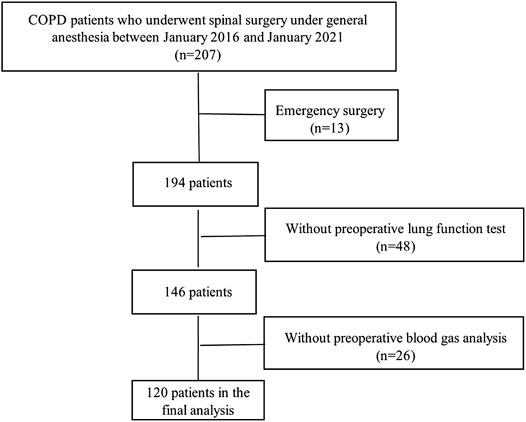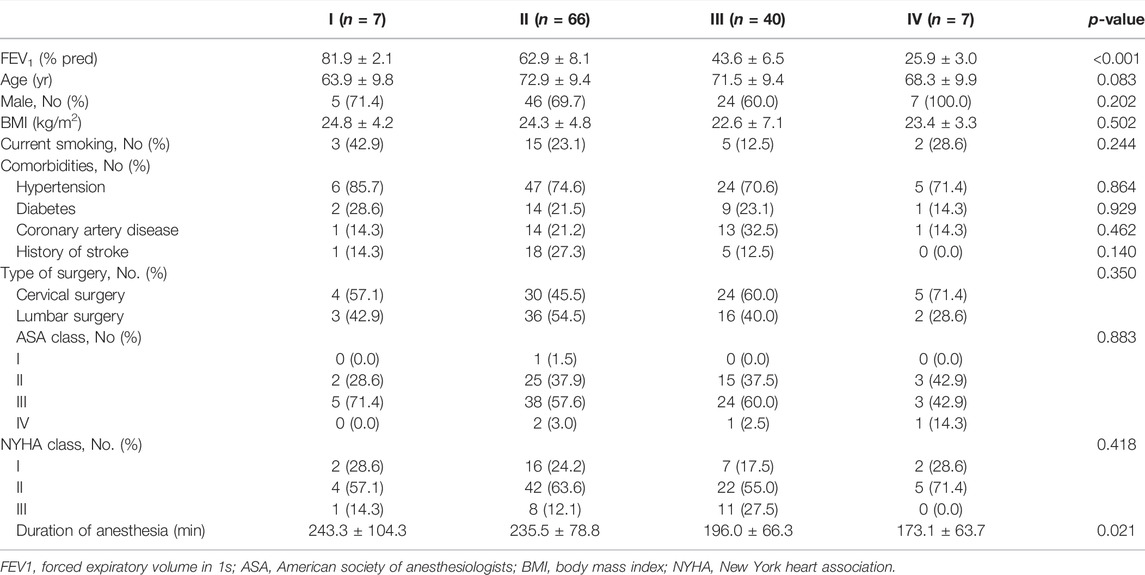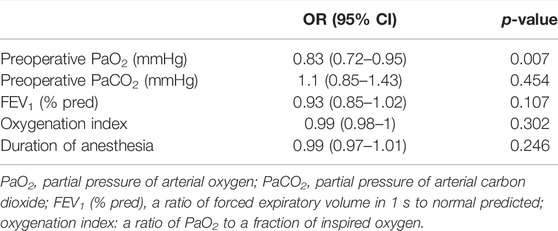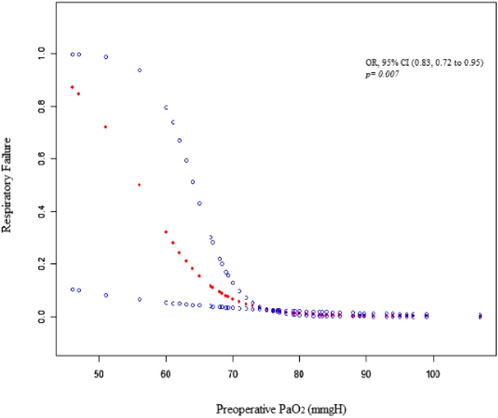- Department of Anesthesiology, Xuanwu Hospital, Capital Medical University, Beijing, China
Background: Chronic obstructive pulmonary disease (COPD) has been considered a risk factor for postoperative respiratory failure after general anesthesia. However, the association between COPD severity and postoperative respiratory failure among COPD patients is unknown. Our aim was to compare the prevalence of postoperative respiratory failure in COPD patients according to disease severity after general anesthesia.
Methods: We retrospectively reviewed COPD patients undergoing spinal surgery with general anesthesia at our clinical center between January 2016 and January 2021. These subjects were divided into four groups (group I = mild COPD, group II = moderate COPD, group III = severe COPD, and group IV = very severe COPD) according to their preoperative lung function. The primary endpoint was a respiratory failure 1 week after surgery. The diagnosis of respiratory failure was made with the presence of one or more of the following criteria: prolonged ventilator dependence, unplanned postoperative intubation, and partial pressure of arterial oxygen (PaO2) ≤ 50 mmHg while the patient was breathing ambient air in the hospital. The extubation time, perioperative PaO2 and partial pressure of arterial carbon dioxide (PaCO2), postoperative lung infection, and length of hospitalization were also compared.
Results: A total of 120 patients who underwent spinal surgery with general anesthesia were included in this retrospective study. Postoperative respiratory failure occurred in 0 (0.0%) patient in group I, 1 (1.5%) patient in group II, 1 (2.5%) patient in group III, and 1 (14.5%) patient in group IV 1 week after surgery (p = 0.219). The duration of anesthesia was 243.3 ± 104.3 min in group I, 235.5 ± 78.8 min in group II, 196.0 ± 66.3 min in group III, and 173.1 ± 63.7 min in group IV (p < 0.001). Preoperative PaO2, PaCO2, intraoperative oxygenation index [a ratio of PaO2 to fraction of inspired oxygen (FiO2)], and postoperative PaO2 were significantly different among the four groups (p < 0.001, 0.001, 0.046, <0.001, respectively). No significant differences among the four groups were seen in extubation time, pulmonary infection, or hospital stay (p = 0.174, 0.843, 0.253, respectively). The univariate analysis revealed that higher preoperative PaO2 was associated with a lower rate of postoperative respiratory failure (OR 0.83; 95% CI, 0.72 to 0.95; p = 0.007).
Conclusion: The severity of COPD as assessed with GOLD classification was not associated with the development of postoperative respiratory failure. However, lower preoperative PaO2 was associated with greater odds of postoperative respiratory failure in COPD patients.
Introduction
Chronic obstructive pulmonary disease (COPD) is a risk factor for postoperative morbidity and mortality (Nafiu et al., 2011; Gupta et al., 2013), and it is associated with prolonged mechanical ventilation after surgery (Licker et al., 2006). Prolonged mechanical ventilation can result in ventilator-induced lung injury and pulmonary infection, which can exacerbate pulmonary function in these high-risk patients (Beitler et al., 2016; Gattinoni et al., 2016). At the same time, delayed weaning is associated with increased hospital stay and treatment costs (Ball et al., 2018; Kocyigit et al., 2021). This places a strain on both surgeons and anesthesiologists (Halbert et al., 2006). Given the circumstances, early extubation is advised. However, clinicians must assess the risk of extubation failure because reintubation increases the risk of hospital-acquired pneumonia by eight times and death by six-twelve times (Liang et al., 2012). It is critical to determine the best time for COPD patients to be extubated after surgery.
According to the Global Initiative for Chronic Obstructive Lung Disease (GOLD) standard (Vogelmeier et al., 2017), COPD can be classified into four stages (mild, moderate, severe, very severe) based on the ratio of forced expiratory volume in 1 second to normal predicted (FEV1% pred). Several preclinical studies and meta-analyses have concluded that epidural or spinal anesthesia is preferable to general anesthesia for COPD patients in order to reduce perioperative complications and prolonged mechanical ventilation (Upchurch et al., 2003; Hausman et al., 2015; Bayrak and Altıntas, 2018). However, due to abnormal coagulation or surgical sites, general anesthesia may be the only option for these patients in some cases (Gulur et al., 2015). Should this be considered a contraindication to selective surgical procedures and general anesthesia, or should surgery be postponed for these high-risk patients? Furthermore, should clinical treatment decisions be individualized to the severity of COPD? We must weigh the risks of general anesthesia against the risk of postoperative complications and patient delays or cancellations. We should not deny patients access to surgical treatments solely because of their comorbidity.
In this observational study, our main objective was to explore the relationship between the severity of COPD patients who underwent spinal surgery and the prevalence of postoperative respiratory failure. Additionally, various candidate risk factors were analyzed to determine whether they were good predictors of postoperative respiratory failure.
Methods
The ethical review board of the Capital Medical University Xuanwu Hospital approved this study (ChiCTR2100049597) and waived the need for informed consent. From January 2016 to January 2021, 120 patients with COPD who had underwent spinal surgery at the Capital Medical University Xuanwu Hospital were included in this study. The data from the Electronic Medical Record were extracted, including demographics, spirometry results, blood gas analysis, comorbidities, postoperative outcomes up to 30 days, and other variables. Patients who required emergent surgery lacked pulmonary function reports, or had other severe organ-system diseases (e.g., cardiovascular and/or neurological illnesses, hepatic and/or kidney dysfunction) were excluded.
The diagnosis of COPD was confirmed by a ratio of FEV1 to forced vital capacity (FVC) less than 70% after inhaling a bronchodilator. COPD patients were divided into four groups according to the severity defined by spirometry tests on the basis of GOLD guidelines (Vogelmeier et al., 2017). Mild COPD was defined as FEV1 ≥ 80% of the predicted value, moderate COPD was defined as 50% ≤ FEV1 < 80% of the predicted value, severe COPD was defined as 30% ≤ FEV1 < 50% of the predicted value, and very severe COPD was defined as FEV1 < 30% of the predicted value.
The primary outcome was a respiratory failure 1 week after surgery. Respiratory failure was defined as the presence of one or more of the following criteria: prolonged ventilator dependence, unplanned postoperative intubation, or PaO2 ≤ 50 mmHg while the patient was breathing ambient air in hospital (Attaallah et al., 2019). Additionally, the extubation time, perioperative PaO2 and PaCO2, postoperative lung infection, and length of hospitalization were reviewed.
Statistical Analysis
All statistical analyses were performed using SPSS 19.0 software. Continuous variables were analyzed with Student’s t test (normal distribution), the Wilcoxon rank test (skewed distribution), or analysis of variance (ANOVA). Categorical data were analyzed using the chi-squared test or Fisher’s exact test. Risk factors for postoperative respiratory failure were identified in a literature review (Attaallah et al., 2019). Univariate analyses were conducted to examine the association between previously potential risk factors (including age, sex, BMI, hypertension, diabetes mellitus, smoking history, ASA score, length of anesthesia, perioperative arterial blood gas, and spirometry findings) and postoperative respiratory failure. Analyses were considered statistically significant at p < 0.05.
Results
Between January 2016 and January 2021, 207 patients were screened for study participation; of these, 120 patients were included in the final analysis of the study; the remaining 87 were excluded from the study due to emergent surgery (n = 13), unavailable preoperative lung function test (n = 48), or lack of preoperative blood gas analysis (n = 26) (Figure 1). These patients were divided into four groups according to the value of FEV1 of the predicted value: group I (n = 7, FEV1% pred 81.9 ± 2.1), group II (n = 66, FEV1% pred 62.9 ± 8.1), group III (n = 40, FEV1% pred 43.6 ± 6.5), and group IV (n = 7, FEV1% pred 25.9 ± 3.0). The preoperative FEV1 of the predicted value was not associated with postoperative respiratory failure in the univariate analyses (Table 3). The duration of anesthesia was 243.3 ± 104.3 min in group I, 235.5 ± 78.8 min in group II, 196.0 ± 66.3 min in group III, and 173.1 ± 63.7 min in group IV (p = 0.021). Baseline characteristics including demographic data, ASA class, New York Heart Association (NYHA) class, and prevalence of individual comorbidities (hypertension, diabetes, coronary artery disease, history of stroke) were generally comparable among the four groups (Table 1).
Perioperative blood gas analyses are shown in Table 2. Preoperative PaO2, PaCO2, intraoperative oxygenation index and postoperative PaO2 were significantly different among the four groups (p < 0.001, 0.001, 0.046, <0.001, respectively). In the univariate analyses, preoperative PaCO2, intraoperative oxygenation index, and the duration of anesthesia were not associated with postoperative respiratory failure (p = 0.454, 0.107, 0.302, and 0.246, respectively) (Table 3). However, higher preoperative PaO2 was associated with a lower rate of postoperative respiratory failure (OR 0.83; 95% CI, 0.72 to 0.95; p = 0.007) (Figure 2). We further applied a two-piecewise linear regression model to examine the threshold effect of the preoperative PaO2 using a smoothing function (Figure 2). We found that a preoperative PaO2 (room air) of less than 68 mmgH was associated with the probability of postoperative respiratory failure.
Postoperative respiratory failure occurred in 1 (1.5%) patient in group II, 1 (2.5%) patient in group III, and 1 (14.5%) patient in group IV 1 week after surgery (p = 0.219). The percentage of patients who needed mechanical ventilation after surgery was also similar (p = 0.497). No other significant differences among the four groups were observed in extubation time, pulmonary infection, or length of hospital stay after surgery (Table 4).
Discussion
The current study indicated that patients with different severity of COPD, defined as FEV1%pred, were not related to postoperative respiratory failure. By analyzing the potential risk factors before surgery, we found that lower PaO2 resulted in a higher rate of respiratory failure after surgery among COPD patients (OR 0.83; 95% CI, 0.72–0.95; p = 0.007). To the best of our knowledge, this is the first study to explore whether the severity of COPD is associated with postoperative respiratory failure undergoing spinal surgery.
Pulmonary function testing is often used to diagnose and evaluate patients’ pulmonary disease (Wang, 2004). Its good quality is influenced by a variety of factors, including subjects’ cooperation, sophisticated technologist, and precise instrumentation (Culver et al., 2017). Sotirios (Kakavas et al., 2021) et al. believed that the calculation of the FEV1 alone has limitations in detecting the underlying complexity of COPD disease. Our study also found that compared to the pulmonary function test, preoperative PaO2 is a more objective and reliable parameter to evaluate the risk of postoperative respiratory failure in COPD patients. Preoperative PaO2 (room air) of less than 68 mmgH was associated with the probability of postoperative respiratory failure.
Many factors can increase the rate of postoperative pulmonary complications (Sabaté et al., 2014; Canet et al., 2015; Yang et al., 2015). COPD is an independent factor after general anesthesia (Manganas et al., 2007; Jonker et al., 2009; Xiao et al., 2020). In the current study, the demographic and preoperative comorbidities were equally distributed, and patients undergoing emergency surgery were excluded. Thus, we expected to exclude the potential bias caused by a mismatch among groups. Fields and Divino’s (2016) study reported that patients with COPD undergoing abdominal procedures had increased morbidity and duration of stay. Unfortunately, they did not analyze the effect of the severity of COPD on postoperative outcomes. No significant differences among the four groups were observed in pulmonary infection or the length of hospital stay after surgery in our study. Such a difference might be attributed to differences in a variety of factors, including surgery type, the duration of surgery, and patient demographic features. Upper abdominal surgery plays an important role in postoperative diaphragmatic dysfunction, a well-known cause of postoperative pulmonary complications (Berdah et al., 2002; Kim et al., 2016). The duration of anesthesia was shorter in patients in group IV than in the other groups; however, neither was an independent predictor for postoperative respiratory failure in the univariate analysis. We speculated that surgeons chose minimally invasive surgery as much as possible to shorten the operation time and reduce postoperative complications.
The present study has several limitations that should be noted. First, this was a retrospective analysis performed at a single center. We were unable to get access to the databases about the intraoperative ventilation strategy and postoperative conditions such as pain and inflammation and which patient used NIV or HFNC after the operation, which may affect outcomes (D'Souza et al., 2020). Second, in the present study, we found that preoperative PaO2 provides a means of objectively evaluating the fitness and can be used to suggest individualized risk stratification in predicting postoperative pulmonary complications. However, the sample size is relatively small which may have affected the statistical power of the comparisons. Third, the blood gas analysis after extubation is not comparable because the test time and inhaled oxygen concentration were different after extubation. Well-designed prospective studies are necessary to address these issues.
Conclusion
Patients with different severities of COPD defined as FEV1%pred were not related to postoperative respiratory failure. However, a lower preoperative PaO2 was associated with greater odds of postoperative respiratory failure in COPD patients.
Data Availability Statement
The raw data supporting the conclusion of this article will be made available by the authors, without undue reservation.
Ethics Statement
The studies involving human participants were reviewed and approved by the ethical review board of Capital Medical University Xuanwu Hospital. Written informed consent for participation was not required for this study in accordance with the national legislation and the institutional requirements.
Author Contributions
RH was responsible for the analysis of the date and wrote the main manuscript. FM, DJ, and QD participated in data collection. CY and QF performed the statistical analysis. TW instructed the details from study design to the study’s completion. All authors contributed to the manuscript revision and approved the final version.
Funding
This study was funded by the Beijing Municipal Health Commission (Jing 2019-2) National Clinical Research Center for Geriatrics.
Conflict of Interest
The authors declare that the research was conducted in the absence of any commercial or financial relationships that could be construed as a potential conflict of interest.
Publisher’s Note
All claims expressed in this article are solely those of the authors and do not necessarily represent those of their affiliated organizations, or those of the publisher, the editors, and the reviewers. Any product that may be evaluated in this article, or claim that may be made by its manufacturer, is not guaranteed or endorsed by the publisher.
References
Attaallah A. F., Vallejo M. C., Elzamzamy O. M., Mueller M. G., Eller W. S. (2019). Perioperative Risk Factors for Postoperative Respiratory Failure. J. Perioper. Pract. 29, 49–53. doi:10.1177/1750458918788978
Ball L., Hemmes S. N. T., Serpa Neto A., Bluth T., Canet J., Hiesmayr M., et al. (2018). Intraoperative Ventilation Settings and Their Associations with Postoperative Pulmonary Complications in Obese Patients. Br. J. Anaesth. 121, 899–908. doi:10.1016/j.bja.2018.04.021
Bayrak M., Altıntas Y. (2018). Comparing Laparoscopic Cholecystectomy in Patients with Chronic Obstructive Pulmonary Disease under Spinal Anesthesia and General Anesthesia. BMC Surg. 18, 65. doi:10.1186/s12893-018-0396-1
Beitler J. R., Malhotra A., Thompson B. T. (2016). Ventilator-induced Lung Injury. Clin. chest Med. 37, 633–646. doi:10.1016/j.ccm.2016.07.004
Berdah S. V., Picaud R., Jammes Y. (2002). Surface Diaphragmatic Electromyogram Changes after Laparotomy. Clin. Physiol. Funct. Imaging 22 (2), 157–160. doi:10.1046/j.1365-2281.2002.00406.x
Canet J., Sabaté S., Mazo V., Gallart L., de Abreu M. G., Belda J., et al. (2015). Development and Validation of a Score to Predict Postoperative Respiratory Failure in a Multicentre European Cohort. Eur. J. Anaesthesiology 32 (7), 458–470. doi:10.1097/eja.0000000000000223
Culver B. H., Graham B. L., Coates A. L., Wanger J., Berry C. E., Clarke P. K., et al. (2017). Recommendations for a Standardized Pulmonary Function Report. An Official American Thoracic Society Technical Statement. Am. J. Respir. Crit. Care Med. 196, 1463–1472. doi:10.1164/rccm.201710-1981st
D'Souza R. S., Gurrieri C., Johnson R. L., Warner N., Wittwer E. (2020). Intraoperative Methadone Administration and Postoperative Pain Control: a Systematic Review and Meta-Analysis. Pain 161, 237–243. doi:10.1097/j.pain.0000000000001717
Fields A. C., Divino C. M. (2016). Surgical Outcomes in Patients with Chronic Obstructive Pulmonary Disease Undergoing Abdominal Operations: An Analysis of 331,425 Patients. Surgery 159 (4), 1210–1216. doi:10.1016/j.surg.2015.11.007
Gattinoni L., Tonetti T., Cressoni M., Cadringher P., Herrmann P., Moerer O., et al. (2016). Ventilator-related Causes of Lung Injury: the Mechanical Power. Intensive Care Med. 42, 1567–1575. doi:10.1007/s00134-016-4505-2
Gulur P., Tsui B., Pathak R., Koury K. M., Lee H. (2015). Retrospective Analysis of the Incidence of Epidural Haematoma in Patients with Epidural Catheters and Abnormal Coagulation Parameters. Br. J. Anaesth. 114, 808–811. doi:10.1093/bja/aeu461
Gupta H., Ramanan B., Gupta P. K., Fang X., Polich A., Modrykamien A., et al. (2013). Impact of COPD on Postoperative Outcomes: Results from a National Database. Chest 143, 1599–1606. doi:10.1378/chest.12-1499
Halbert R. J., Natoli J. L., Gano A., Badamgarav E., Buist A. S., Mannino D. M. (2006). Global burden of COPD: Systematic Review and Meta-Analysis. Eur. Respir. J. 28, 523–532. doi:10.1183/09031936.06.00124605
Hausman M. S., Jewell E. S., Engoren M. (2015). Regional Versus General Anesthesia in Surgical Patients with Chronic Obstructive Pulmonary Disease. Anesth. analgesia 120, 1405–1412. doi:10.1213/ane.0000000000000574
Jonker F. H. W., Schlösser F. J. V., Dewan M., Huddle M., Sergi M., Dardik A., et al. (2009). Patients with Abdominal Aortic Aneurysm and Chronic Obstructive Pulmonary Disease Have Improved Outcomes with Endovascular Aneurysm Repair Compared with Open Repair. Vascular 17, 316–324. doi:10.2310/6670.2009.00049
Kakavas S., Kotsiou O. S., Perlikos F., Mermiri M., Mavrovounis G., Gourgoulianis K., et al. (2021). Pulmonary Function Testing in COPD: Looking beyond the Curtain of FEV1. Npj Prim. Care Respir. Med. 31, 23. doi:10.1038/s41533-021-00236-w
Kim H. J., Lee J., Park Y. S., Lee C. H., Lee S. M., Yim J. J., et al. (2016). Impact of GOLD Groups of Chronic Pulmonary Obstructive Disease on Surgical Complications. Int. J. Chron. Obstruct Pulmon Dis. 11, 281–287. doi:10.2147/COPD.S95046
Kocyigit H., Gunalp M., Genc S., Oguz A. B., Koca A., Polat O. (2021). Diaphragm Dysfunction Detected with Ultrasound to Predict Noninvasive Mechanical Ventilation Failure: A Prospective Cohort Study. Am. J. Emerg. Med. 45, 202–207. doi:10.1016/j.ajem.2020.08.014
Liang B.-M., Lam D. C. L., Feng Y.-L. (2012). Clinical Applications of Lung Function Tests: a Revisit. Respirology (Carlton, Vic) 17, 611–619. doi:10.1111/j.1440-1843.2012.02149.x
Licker M. J., Widikker I., Robert J., Frey J.-G., Spiliopoulos A., Ellenberger C., et al. (2006). Operative Mortality and Respiratory Complications after Lung Resection for Cancer: Impact of Chronic Obstructive Pulmonary Disease and Time Trends. Ann. Thorac. Surg. 81, 1830–1837. doi:10.1016/j.athoracsur.2005.11.048
Manganas H., Lacasse Y., Bourgeois S., Perron J., Dagenais F., Maltais F. (2007). Postoperative Outcome after Coronary Artery Bypass Grafting in Chronic Obstructive Pulmonary Disease. Can. Respir. J. 14 (1), 19–24. doi:10.1155/2007/378963
Nafiu O. O., Ramachandran S. K., Ackwerh R., Tremper K. K., Campbell D. A., Stanley J. C. (2011). Factors Associated with and Consequences of Unplanned post-operative Intubation in Elderly Vascular and General Surgery Patients. Eur. J. anaesthesiology 28, 220–224. doi:10.1097/eja.0b013e328342659c
Sabaté S., Mazo V., Canet J. (2014). Predicting Postoperative Pulmonary Complications. Curr. Opin. Anaesthesiol 27 (2), 201–209. doi:10.1097/aco.0000000000000045
Upchurch G. R., Proctor M. C., Henke P. K., Zajkowski P., Riles E. M., Ascher M. S., et al. (2003). Predictors of Severe Morbidity and Death after Elective Abdominal Aortic Aneurysmectomy in Patients with Chronic Obstructive Pulmonary Disease. J. Vasc. Surg. 37, 594–599. doi:10.1067/mva.2003.22
Vogelmeier C. F., Criner G. J., Martinez F. J., Anzueto A., Barnes P. J., Bourbeau J., et al. (2017). Global Strategy for the Diagnosis, Management, and Prevention of Chronic Obstructive Lung Disease 2017 Report. GOLD Executive Summary. Am. J. Respir. Crit. Care Med. 195, 557–582. doi:10.1164/rccm.201701-0218pp
Wang J.-S. (2004). Pulmonary Function Tests in Preoperative Pulmonary Evaluation. Respir. Med. 98, 598–605. doi:10.1016/j.rmed.2004.01.007
Xiao F., Yang J., Fan R. (2020). Effects of COPD on In‐hospital Outcomes of Transcatheter Aortic Valve Implantation: Results from the National Inpatient Sample Database. Clin. Cardiol. 43, 1524–1533. doi:10.1002/clc.23475
Keywords: COPD, general anesthesia, respiratory failure, spinal surgery, lung function test
Citation: Hou R, Miao F, Jin D, Duan Q, Yin C, Feng Q and Wang T (2022) General Anesthesia for Patients With Chronic Obstructive Pulmonary Disease and Postoperative Respiratory Failure: A Retrospective Analysis of 120 Patients. Front. Physiol. 13:842784. doi: 10.3389/fphys.2022.842784
Received: 24 December 2021; Accepted: 14 April 2022;
Published: 30 May 2022.
Edited by:
Lorenzo Ball, University of Genoa, ItalyReviewed by:
Michela Rauseo, University of Foggia, ItalyAzadeh Yadollahi, University Health Network, Canada
Copyright © 2022 Hou, Miao, Jin, Duan, Yin, Feng and Wang. This is an open-access article distributed under the terms of the Creative Commons Attribution License (CC BY). The use, distribution or reproduction in other forums is permitted, provided the original author(s) and the copyright owner(s) are credited and that the original publication in this journal is cited, in accordance with accepted academic practice. No use, distribution or reproduction is permitted which does not comply with these terms.
*Correspondence: Tianlong Wang, d190bDU1OTVAaG90bWFpbC5jb20=
 Ruixue Hou
Ruixue Hou Fangfang Miao
Fangfang Miao Tianlong Wang
Tianlong Wang




